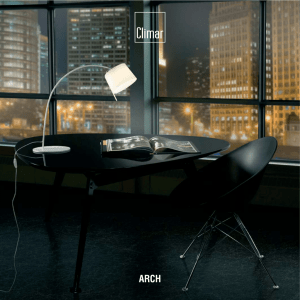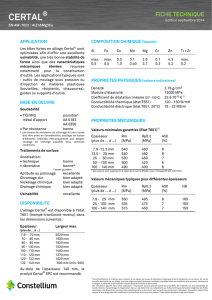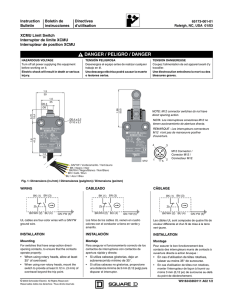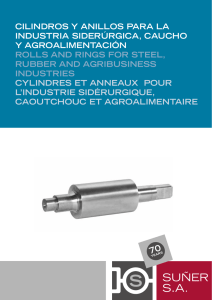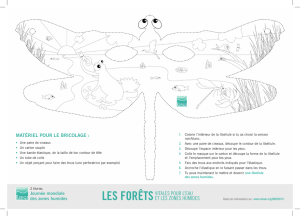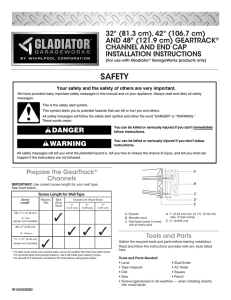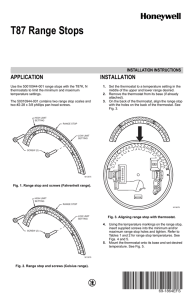The masonry arch between «limit» and «elastic» analysis. A critical
Anuncio
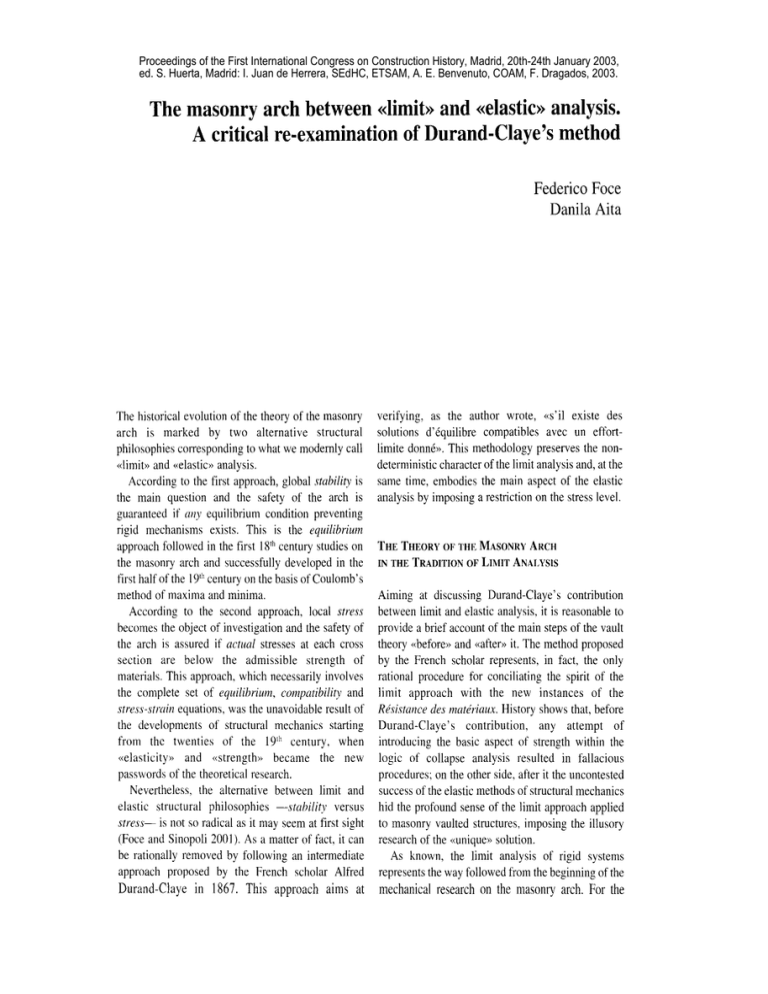
Proceedings of the First International Congress on Construction History, Madrid, 20th-24th January 2003,
ed. S. Huerta, Madrid: I. Juan de Herrera, SEdHC, ETSAM, A. E. Benvenuto, COAM, F. Dragados, 2003.
The masonry arch between «limit» and «elastic» analysis.
A critical re-examination of Durand-Claye's method
Federico Foce
Danila Aita
The historical evolution of the theory of the masonry
arch is marked
by two alternative
structural
philosophies corresponding to what we modernly call
«limit» and «elastic» analysis.
According to the first approach, global stability is
the main question and the safety of the arch is
guaranteed if any equilibrium condition preventing
rigid mechanisms
exists. This is the equilibrium
approach followed in the first 18th century studies on
the masonry arch and successfully developed in the
first half of the 19thcentury on the basis of Coulomb' s
method of maxima and minima.
According to the second approach, local stress
becomes the object of investigation and the safety of
the arch is assured if actual stresses at each cross
section are below the admissible
strength
of
materials. This approach, which necessarily involves
the complete set of equilibrium, compatibility and
stress-strain equations, was the unavoidable result of
the developments
of structural mechanics starting
from thc twenties
of the 19th century,
when
«elasticity»
and «strength»
became
the new
passwords of the theoretical research.
Nevertheless,
the alternative between limit and
elastic structural philosophies
-stability
versus
stressis not so radical as it may seem at first sight
(Foce and Sinopoli 200 1). As a matter of fact, it can
be rationally removed by following an intermediate
approach proposed by the French scholar Alfred
Durand-Claye
in
1867.
This
approach
aims
at
verifying, as the author wrote, «s'il existe des
solutions d'équilibre
compatibles avec un effortlimite donné». This methodology preserves the nondeterministic character of the limit analysis and, at the
same time, embodies the main aspect of the elastic
analysis by imposing a restriction on the stress level.
THE THEORY OF THE MASONRY ARCH
IN THE TRADITION OF LIMIT ANALYSIS
Aiming at discussing Durand-Claye's
contribution
between limit and elastic analysis, it is reasonable to
provide a brief account of the main steps of the vault
theory «before» and «after» it. The method proposed
by the French scholar represents, in fact, the only
rational procedure for conciliating the spirit of the
limit approach
with the new instances
of the
Résistance des matériaux. History shows that, before
Durand-Claye' s contribution,
any attempt
of
introducing the basic aspect of strength within the
logic of collapse analysis resulted in fallacious
procedures; on the other side, after it the uncontested
success of the elastic methods of structural mechanics
hid the profound sense of the ]imit approach applied
to masonry vaulted structures, imposing the illusory
research of the «unique» solution.
As known, the limit analysis of rigid systems
represents the way followed from the beginning of the
mechanical research Oil the masonry arch. For the
896
F. Foce, D. Aita
are speaking of the first 18th century
studies on the subjectit was certainly the only
possible, as it requires nothing but the laws of
equilibrium. No matter of stress, strain and actual
strength enters the problem of the arch, nor could it be
otherwise. As asserted by Coulomb following Bossut,
masonry is «composé de fibres roides, ou qui ne sont
susceptibles ni de compression, ni d'alongement»
(Coulomb 1773, 351). In short, the masonry arch is
seen as an assemblage of rigid and infinitely resistant
voussoirs subject to the constraint of impenetrability
and to the friction resistance (cohesion of the mortar,
if present, is usually considered as negligible). If the
equilibrium of such an assemblage is impossible, this
means that the voussoirs will take some relative
movements
which transform
the arch into a
mechanism. These movements may be both rotations
around the edge of the joints or slidings along the
surface of the joints. By properly combining rotations
and slidings at different joints the complete spectre of
the collapse modes can be derived. The main purpose
of limit analysis is exact]y to assure that, for an arch
of given geometry, load and friction coefficient, no
collapse mechanism can occur.
For at least one hundred and fifty years theoretical
investigation dealt with the analysis of the collapse
mechanisms
and the consequent
design of the
structural elements (thickness of the arch, size of the
piers etc.). Initially, this investigation was developed
on the base of simplified or arbitrarious hypotheses
about the location of the rupture joints, the types of
collapse mechanisms, the role of friction. The socalled «wedge theory» formulated by La Rire in 1712
is probably the first example of this type.
From a theoretical point of view, however, a real
improvement of the limit analysis may be found only
in the well-known Essai by Coulomb (] 773). The
method of maxima and minima, introduced
by
Coulomb together with a rational way of quantifying
the role of friction, makes the complete discussion of
the collapse modes of a symmetric arch in terms of
statically admissible thrusts possible. The conditions
of stable equilibrium
can then be expressed by
disequalities between the extreme values of the crown
thrust which prevent the rotational and translational
movements of a voussoir.
To tell the truth, Coulomb did not fuIJy develop his
method, as he failed to analyse all the possible
rotations of a voussoir in relation to the application
time -we
point of the thrust at the extrados and intrados of the
crown joint. As recently shown (Foce 2002), the
general treatment of the problem was given by Persy
in 1825 and Navier in ] 826, almost fifty years after
Coulomb, and the complete discussion of the eight
collapse modes of a symmetric arch was given by
Michon in 1857.
The theoretical contribution of these authors can be
summarized as follows. For a symmetric arch, let's
consider the limit equilibrium of a generic voussoir
-sub tended by the angle 8 and subject to its own
weight W( 8) and the horizontal
crown thrust
(Figure 1)- with respect to the four rigid movements
of downwards
sliding, upwards sliding, rotation
around the intrados edge, rotation around the extrados
edge. The corresponding values of the thrust are:
for the downwards sliding
A = W/tang( qJ+ 8)
for the upwards sliding
Al = Wltang( qJ- 8)
for rotation
around
the intrados
edge
for rotation around the extrados edge
= W x/Yi
B
BI
= W x/Y,
where qJis the friction angle and
Xi' X", Yi' Y" are the
lever arms of weight and thrust from the intrados and
extrados edges.
)
I
I
,
I
I
I
:Ye
I
I
Figure 1
According to the method of maxima and minima,
with respect to 8 the greatest values of the thrust
corresponding
to the inwards movements of the
The masonry arch between «¡¡mit" and «elastio, analysis
voussoir -that
is max(A) and max(B)and the
smallest
values corresponding
to the outwards
movements -that
is min(A¡) and min(B¡)must
be determined.
Moreover,
for the geometrical
compatibility in the case of mechanisms with relative
rotation at the crown joint, the thrust must be applied
at the extrados or the intrados of the crown. Thus,
conserving the notations max(B) and min(B) when
the thrust is applied at the crown extrados, the new
notations max(b) and min(b) must be introduced
when it is applied at the crown intrados.
The six extreme values of the thrust -max(A),
max(B), max(b), min(A), min(B) and min(b)are
associated with the six rupture joints [A], [B], lb],
[AJ, [B) and [b). The relative location of the
rupture joints makes it possible to deduce the
complete spectre of the collapse mechanisms. As
shown by Persy, Navier and Michon, there are eight
collapse modes for a symmetric arch (Figure 2).
According to the method of maxima and minima,
none ofthem can occur if max(A, B) < min(A" B) for
thrust applied at the crown extrados, and max(A, b) <
min(
b ,) for thrust applied at the crown intrados.
A"
Equilibrium becomes unstable -so that collapse can
occurwhen one of the following conditions is
fulfilled:
1 mode
II mode
III mode
IV mode
V mode
VI mode
VII mode
VIII mode
max(B)
= min(B¡)
= min(b)
max(B) = min(A¡)
max(B) = min(A)
max(b)
max(A)
= min(A¡)
max(A)
= min(A¡)
max(A)
= min(b¡)
= min(b¡)
max(A)
ELASTICITY AND STRENGTH:
with
with
with
with
with
with
with
with
[B]
[b]
[B]
[B]
[A]
[Al
[A]
[A]
over [B)
under [b)
over [A)
under [A)
over [A¡]
under [A)
over [b)
under [b)
NEW PASSWORDS
OF 19TH CENTURY THEORETlCAL
897
published his Le¡;:ons on the mathematical theory of
elasticity,
the first comprehensive
book on the
subject;
in 1855 Saint-Venant
completed
his
fundamental
memoirs on the elastic flexure and
torsion of beams.
During
this revolutionary
development
of
structural mechanics in the name of «elasticity» and
«strength»,
the research
on the masonry
arch
followed
its own way, in confirmation
of the
persistent
distinction
between
construction
en
charpente and construction en mar;onnerie. Persy's
Cuurs and Navier' s Résumé are good examples of this
state of things. Both the treatises are mainly devoted
to the new themes of the Résistance des matériaux
and contain separate sections dealing with the
stability of masonry arches and retaining walls in the
tradition of limit analysis.
Nevertheless, the signs of the new times were
becoming more and more manifest. It is not by
chance that the first clear hint towards the el as tic
interpretation of the masonry arch may be found in
the same Résumé des Ler;ons by Navier. As we have
seen, this book contains the correct discussion of the
stability conditions on the base ofCoulomb's method.
After this discussion, however, Navier takes into
account the actual strength of masonry and suggests
an apparently small revision of the results of limit
analysis. Examining
the first rotational collapse
mode, for instance, he interpretes the opening at the
rupture joints as the incipient cracking corresponding
to the triangular stress distribution
on the joint
surface. This interpretation is of liule consequence in
quantitative terms, as it provides a slight variation of
the extreme values of the crown thrusts calculated in
accordance with the collapse approach. It represents,
however, a radical turn from a qualitative point of
view. Navier's idea, in fact, is declared in the
statement that,
RESEARCH
The years of Persy, Navier and Michon's fundamental
works are very significative not only for the theory of
the masonry arch but also as they correspond to the
period during which the theories of elasticity and
strength of materials
were being scientifically
formalised. In the twenties Navier himself, Cauchy
and Poisson laid the foundation of the general theory
of the elastic bodies, followed some years later by
Lamé, Clapeyron and Saint-Venant. In 1852 Lamé
les voussoirs n' étant pas des corps parfaitement durs, on
ne peut admettre que les pressions s' exercent ainsi contre
des aretes. Cela n'empeche
pas que l'on ne puisse
calculer, avec une exactitude suffisante, l'équilibre des
voutes d' apres les regles énoncées précédemment: mais il
parait nécessaire d'avoi égard a l'élasticité de la matiere
des voussoirs . . . Cette question serait un cas particulier
d'une question plus générale. qui consiste a déterminer
les effets qui se produisent dans un corps élastique de
figure quelconque, soumis a ]'action de diverses forces.
(Navier 1826, 164-165)
898
F. Foce. D. Aita
[A¡J
n mode
Imode
ma.x(B) = min(B¡)
max(b)
ID mode
max(B) = min(A¡)
N mode
ma.x(B) = min(A¡)
= min(b¡)
[A]
[Ad
V mode
ma.x(A) = min(A¡)
vn mode
lb¡
max(A)
= min(b¡)
Figure 2
The eight collapse modes of a symmetric arch (redrawn from Michon 1857)
VI mode
max(A) = min(A¡)
VllI mode
max(A)
= min(b¡)
The masonry arch between «limit» and «elastic» analysis
As it is easy to understand from our modern
viewpoint, Navier's hint towards the elastic treatment
of the masonry arch requires one to abandon the logic
of the collapse approach and to set up the proper
methodology for solving elastic hyperstatic systems.
This methodological
turn was not immediate and
Navier himself did not draw all the consequencies of
his idea. As a matter of fact, history shows that from
Navier's hint to its conscious acceptance almost fifty
years passed during which the theory of the arch tried
to coinciliate the traditional approach in terms of limit
analysis with the news claims in the name of strength
and elasticity.
The first, and perhaps, most eloquent example of
this contradictory
state of things is Méry' s wellknown memoir of 1840. In spite of the great success
of the so-called Méry' s rule -the only one still quoted
in to-day' s textbooksMéry' s paper manifestly
testifies this methodological
incoherence. The first
part of the memoir is an interesting discussion of the
rotational collapse modes by means of the new
graphic tool of the thrust line, introduced by Gerstner
in 1833. In particular, Méry starts from Boistard' s
experimental results and Audoy's theoretical analysis
in order to «translate» the limit conditions of stability
in terms of thrust line. This part of the memoir is
intentionally developed «dans I'hypothese abstraite de
matériaux infinitement résistants» and describe the
«équilibre
mathématique»
corresponding
to the
collapse of the arch.
In the second part of the paper Méry considers the
actual strength of masonry. In this case the thrust line
ne peut donc jamais atteindre l' extrémité des voussoirs, et
el1e s'en éloignera d'autant plus que les matériaux serant
plus mous. Par conséquent el1e sera renfermée dans des
limites plus resserrées
que ce11es que nous avons
considéréesjusqu'a
présent. (Méry 1840,64)
These new limits are fixed by Méry on the basis of
the very personal criterium for which the distance of
the thrust line from the extrados and intrados «doit
etre assez grand pour supporter les deux tiers de la
pression totale», (Méryl840, 64). Méry's basic idea
is summarized
in the following
reasonement
(Figure 3):
899
lateral bands DO' and dd'] dépend de la pression et de la
qualité des matériaux; 1'autre ¡the central band d'O'],
dépend de la forme de la voúte. On pourra déterminer la
premiére d'aprés cette condition que 1'on ne doit pas
attendre des matériaux un effort permanent supérieur au
dixiéme de celui qui l'écraiserait;
quant a I'intervalle
[d'O'], il doit offrir a la courbe des pressions assez de
latitude pour qu'el1e y soit toujours renfermée. (Méry
1840,65)
I
I
I
I
I
I
I
I
I
I
I
I
I
I
I
I
I
I
I
I
I
I
I
L_-____-------------
Figure 3
By this criterium,
la question de ]a solidité des voútes est ramenée a celle de
leur équilibre mathématique.
Ainsi, il n'y aura qu'une
seule courbe des pressions possible, si l'interval1e [of the
central bandl est réduit au minimum nécessaire a la
stabilité de la voúte; mais au contraire si, pour plus de
securité. l'on rend cet interval1e un peu plus grand, il
existera une infinité de positions admissibles a priori pour
la courbe des pressions . . . (Méry 1840,65).
Nous partageons par la pensée la longuer des joints en
deux parties qui doivent étre soumis a des considérations
As we can see, Méry saves the reference -also
linguisticto the logic of limit analysis and
improperly takes it as the basis for analysing a stable
arch with finite
compressive
strength.
This
contradictory line of reasoning is a Leitmotiv of 19th
century literature on the arch theory. Scheft1er, for
instance, studies in detail the properties of the lines of
maximum and minimum thrust under the assumption
of infinitely resistant material. Dealing then with the
tout a faít diíférentes; I'une [comprehending the two
«Pressbarkeit
des Materials», he states that in a stable
900
F. Foce, D. Aita
arch the thrust line must run within a central strip
whose thickness is half the arch thickness (Scheffler
1857,69).
Another example from the American context is
W oodbury' s treatise. Referring to tbe studies on the
collapse analysis by Coulomb, Audoy and Petit,
Woodbury gives a correct treatment 01' what he calls
the !ine 01' «ultimate» thrust. Coming then to consider
the actual strength 01' masonry, he states that for a
well-proportioned
arch «the curve 01' pressure should
lie entirely between two other curves which divide the
joints into three equal parts» (Woodbury 1858,329).
Among the thrust lines which can be drawn within
these two curves, he se1ects that one -called
line 01'
«actual» thrust- which passes
through the limits already fixed; viz., at the key, 1/3 the
length of the joint from the extrados, and at the reins, 1/3
of the joint from the intrados . . . We have here a perfectly
distinct point of departure for a new ca1culation of the
thrust of arches. (Woodbury 1858,332)
For a strange way 01' reasoning, what should be
good for the safety 01'the arch -that is the absence 01'
crackingbecomes what actually occurs for the
engineer's
satisfaction.
In spite 01' Woodbury's
conviction
01' having
discovered
«an exact
mechanical foundation for a theory of the actual
thrust», we recognize
here, once more, abad
compromise between different approaches.
This same compromise
vitiates an anonimous
Cours de ponts used in the sixties as textbook for the
students 01'the École des Ponts et Chaussées at Paris.
The idea that the actual thrust line must run within a
central band is applied to different practical cases
«d' apres la nature meme de la voúte». Thus, for a
vault «a construire avec soin, dan s des conditions
ordinaires», the central band will have a thickness 01'
1/3 01' the arch; in the case 01' «voútes faites avec des
mortiers médiocres ou construites dans une mauvaise
saisoD», the central band will be 1/4 01' the arch
thickness; finally, «pour des voútes executées avec
perfection» the thrust will be applied to the middle
point 01' the joints at the crown and the haunch.
Obviously, there is no reason for regarding these
choises 01' the thrust line as the correct ones. They
simply remove the statical indetermination
when
stable conditions 01'equilibrium are analysed. In other
words, the central band may be useful for !imiting the
part of the arch ring where the thrust line should
preferably lie but, as clearly remarked
with reference to Méry's thrust !ine,
by Poncelet
cette courbe elle-méme reste indéterminé, a moins de
supposer fictivement la rupture de I'équilibre par rotation
autour des arete s des plan s de joints limités aux nouveaux
intrados et extrados, ce qui réclamerait des calculs ou
tatonnements fort pénibles et peu justifiés en principe.
(Poncelet 1852, 539-540)
AIMS AND FEATURES OF DURAND-CLAYE'S
METHOD
The contradictory
context above out]ined is the
background in which Durand-Claye's
contribution
must be placed. As we have seen, this uncertainty is
fundamentally connected to the meaning of the thrust
line drawn in accordance with Méry's or similar
methods, based on two a priori assumptions for
removing
the statical
indetermination.
Some
reasonable
doubts arise: for instance, do those
assumptions lead to a statically admissible solution in
terms of strength throughout the arch ring? Do they
correspond to some type of limit condition ? Where
are the weak joints of the arch?
Before tackling these questions and exposing his
method, Durand-Claye develops a deep discussion
about the Principe de l'emploi des courbes de
pression; valeur de la méthode. The point is the
following: is the value of the results obtained by
means of the thrust line comparable with that assured
by the formulas 01' the strength of material s usually
adopted for the analysis of metallic arches') To sol ve
this point, says Durand-Claye,
il suffit
connues
les arcs
agir sur
de se reporter un instant aux méthodes bien
qui ont servi a établir les formules usitées pour
métalliques: l'expérienee a montré qu'en faisant
les matériaux des forces déterminées et limitées,
il se produisait entre ces force s et les actions moléculaires
un état d'équilibre . . . Mais dan s toutes ces expériences
d'élasticité statique, on négligeait forcément l'étude du
développement de ees forces moléeulaires; on constatait
un résultat. Lorsque ensuite dan s les calculs d'une poutre
ou d'un are métallique, on emploie ces formules qui ne
sont que l' énoncé de certaines faits . . . on vérifie
seulement que le systeme projeté admettra les solutions
les formules;
on
d' équilibre auxquelles
s' appliquent
néglige les causes mal définies qui pouITont venir influer
pendant la pose ou le décintrement sur le développement
des forces moléculaires,
comme
elles ont pu intervenir
The masonry arch between <<limit»and «elastic» analysis
dans la mise en expériences des tiges ou des fils qui
servaient a formuler les lois de l' élasticité statique. A vec
les dimensions calculées. I'équilibre sera possible, mais
d'une fa<;:on mathématique
on ne peut affirmer sa
nécessité, puisqu'on n'est pas parti de I'état initial du
systeme. (Durand-Claye
1867,64)
For stone or masonry arches the formulas of the
strength of material s are abandoned in favour of the
graphical tool of the thrust line. Now, continues the
author,
pour que le tracé de cette courbe ait quelque valeur et soit
autre chose qu'une série de constructions géométriques, il
convient de définir rationellement la poussée qui lui sert
d' origine. Achaque valeur prise pour la poussée, achaque
point d'application correspond une courbe de pression: on
cherche
si parmi ces courbes
il s' en trouve une
correspondant a une solution d'équilibre. Autrement dit,
on cherche
si l' ouvrage
étudié avec ses charges,
surcharges, profils, admet une combinaison de la poussée
et des poids telle qu' en aucun point les matériaux
n'atteignent la résistance limite qui leur est imposée. Ainsi
recherche de la possibilité d'une solution d'équilibre,
voila que! est le véritable sens de la construction et des
tatonnements
indiqués par M. Méry. Le résultat est le
meme que pour l'arc métallique: l'ouvrage admettra au
moins une solution d'équilibre . . . mais nous négligeons
toujours les causes accessoires qui peuvent se développer
au décintrement;
de la possibilité de l'équilibre, nous
concluons a la stabilité. (Durand-Claye 1867.65)
901
Which is, then, the right way for avoiding any
arbitrarious
hypothesis?
Here is Durand-Claye's
answer:
Nous ne déterminerons
plus, un peu au hasard, une
solution quelconque d'équilibre: connaissant les profils,
les charges, la résistance effective ou réduite imposée aux
matériaux, nous déterminerons
par des constructions
géométriques toutes les solutions d'équilibre quc peut
comporter une voúte. Nous ferons ainsi une application
généralisée de la méthode des courbes de pression. Cette
représentation complete. . . aura sur le tracé d'une courbe
unique un double avantage: 10 elle permettra de suivre
tous les modes de répartition qui pourront se produire tant
que la voúte sera en équilibre; elle mettra en évidence
l'influence de la résistance des matériaux et montrera les
points réellement
faibles;
2° elle pouna
de plus
s'appliquer
également bien a tous les exemples; elle
permettra par la constance des ses procédés d'effectuer
une étude réellement comparative des divers types, en
tenant compte des différences de résistance et non plus
seulement
des épaisseurs
et des profils, conditions
purement géométriques. (Durand-Claye
1867,66)
il n' échappe a personne que le tracé habituel de ces
courbes présente une sorte de vague et d'incertitude. On
n'arrive a trouver une courbe d'équilibre.
que seule
mérite
le nom de courbe
de pression,
que par
tatonnements, en prenant arbitrairement deux points pour
déterminer la courbc ou faisant varier la poussée en
grandeur et en position, ce qui revient toujours a prendre
au sentiment les deux conditions nécessaires pour définir
la courbe. On n' a aucune idée du degré de stabilité de la
voúte, puisqu'on s'arrete dés qu'une courbe d'équilibre
est trouvée et que la voúte peut en comporter une infinité;
l'influence
de la résistance des matériaux n'est point
suffisamment mise en évidence et les parties faibles du
profil sont indiquées avec un certain vague. (Durand-
The idea is clear. Instead of searching for a single
thrust line regarding it as the «actuai» one, al! the
admissible thrust lines have to be determined. Among
them also the true one will be necessarily comprised in
the case of a well-designed arch. This procedure
overturns the deterministic logic of Méry's or similar
methods (as well as the elastic methods for hyperstatic
systems). Its value resides exactly in checking the
existence of admissible solutions without requiring to
find the true one: as Durand-Claye writes, «de la
possibilité de l' équilibre, nous concluons a la stabilité».
As it is easy to understand,
we find here a
particular form of what we modernly call the sate
theorem of limit analysis. This theorem is implicit
also in the stability conditions of Persy, Navier and
Michon. The only difference is that now the range of
admissible solutions is restricted in order to consider
the actual strength of materials. In this sense DurandClaye's method is a rational mediation between limit
and elastic approach.
Obviously,
the ultimate
condition according to Durand-Claye
is not the
collapse condition of limit analysis, unless one takes
an infinite value of the compressive strength and
neglects the tensile strength.
What we have said has been «translated»
by
Durand-Claye into an eloquent graphic construction
Claye 1867, 65-66)
based on the following steps:
In other words, «le principe méme de J'emploi des
courbes de pression suivant la méthode de M. Méry,
semble donc avoir une valeur comparable a celle des
théories admises dans la résistance des matériaux».
However,
902
F. Foce, D. Aita
Research of the admissible thrusts for the
rotational and translational equilibrium of a
generic voussoir
Durand-Claye
considers
a symmetric
arch and
examines the ideal voussoir between the crown joint
c(A, and a generic joint cd (Figure 4, left). Let's
suppose that the resultant of the horizontal thrust and
the weight W of the voussoir goes through the point a
of cd. By varying the application point of the thrust
from Coto do maintaining fixed point a, the thrusts will
then be measured by horizontal segments drawn from
the crown joint c{ldoto the line A(,Bo; for a coinciding
with c and d, the two lines aof3o and Yo~)are similarly
obtained, so that the area aof3oYrA, contains the
extremes of the segments measuring the admissible
thrusts for the rotationa] equilibrium of the voussoir.
Consider
now the normal component
of the
resultant on the joint cd. For values of the thrust
corresponding
to Ao and Bo' it is measured by
segments bounded by the joint cd and the points A
and B, respectiveIy; in a similar way, the pair of
points
ao' 130and YrJ'80 of the area aof3oYo8oat the
crown joint correspond to the pairs of points a,
13 and
To keep account of the translational equilibrium
along cd, it is sufficient to draw at point a the friction
cone, defined by the friction angle qJ. Let' s take the
weight W applied at point {l and consider the two
horizontal thrusts which give a resultant coinciding
with the boundaries of the cone. These thrusts define
two vertical lines at the crown between which the
extremes of the segments representing the admissible
thrusts for the transational equilibrium are comprised.
To assure both the rotational and translational
equilibrium at the joint cd, the admissible thrusts
must be comprised within the intersection of the area
aof3oYrJ80with the two vertical lines. By repeating this
procedure for every joint Durand-Claye finds the area
within which the extremes of the statically admissible
thrusts must be included. Tf this area shrinks lO a
single point, equilibrium becomes unstab]e and a
collapse mechanism can occur. Up to this phase, the
procedure graphicaIly translates the results already
obtained in analytical terms by Persy, Navier and
Michon.
this
Research of the admissible thrusts with respect to
the strength of material at a generic joint
area contains
the extremes
of the segments
perpendicular
to cd, which measure the normal
components corresponding to the admissible thrusts
for the rotational equilibrium.
The innovation of Durand-Claye's
method concerns
the introduction of finite valucs of the compressive
and shear strength. Let 0"" be the admissible value of
y, 8 of the area af3y8 at the joint cd; therefore,
d
J~-J1I r
80
Bo Po
Co
ro
Figure 4
Durand-Claye's method (redrawn from Durand-Claye 1867)
903
The masonry arch between «limit» and «elastic» analysis
the compressive strength, N the normal force at the
joint cd and e the eccentricity of its application point.
Assuming the usual linear law for the normal stress
distribution, the force N for which the value 0* is
reached at the most compressed edge of a rectangular
section of height h and width bis:
(1)
N
= (j" * bh'
for
h + 61e1
(2)
=
N
(j"
~
*
b(~
-
lel) for
lels~
~
6
s lels
6
~
2
Figure 5
The «area 01' stability» 01' Durand-Claye's method (from
Durand-Claye 1867)
Equation (1) represents two symmetric hyperboles
having as asymptotes the joint line and the straight
lines e
= :!: h/6, respectively.
Equation (2) represents
= :!: h/2 and
tangent to the hyperboles for e = :!: h/6 (Figure 4,
Research
right). Thus, the area cúXI contain the admissible
normal components with respect to the compressive
strength. A similar area eowodo can be drawn for the
admissible thrusts at the crown joint.
With regard to the shear component, Durand-Claye
represents the admissible shear force S on ed by
means of the segments at, at'o Applying the weight W
to a and drawing the perpendiculars to ed from t and
t', two segments can be obtained by intersecting these
perpendiculars with the horizontal straight line from
the extremity of the weight. These segments define
two vertical straight lines at the crown between which
the admissible thrusts with respect to the shear force
on ed are contained.
Imagine now to repeat the preceding constructions for
every joint. This operation defines, if it actually
exists, the «area of stability» common to all the areas
rspq. For a well-designed arch, the area of stability is
a curvilinear quadrilateral of the type r¡sp¡q¡, in the
sense that it corresponds to the joints c¡d¡ and e/r Its
form and dimension immediately
provide useful
information about the safety of the arch, the position
of the admissible thrust lines and the location of the
most compressed joints. When the area of stability
shrinks to a point, the limit condition is attained and a
unique admissible thrust line exists. For example, if
two straight lines with nil value for e
Research
equilibrium
of the admissible
and strength
thrusts
with respect
at a generic
to
equilibrium
the area
of the admissible
and strength
r¡sp¡q¡ is reduced
thrusts
with respect
throughout
to the point
to
the arch
r¡
= p¡'
this
means that the limit compression is reachetl) at the
crown extrados, at the intrados of the joint ed"and
at
,
the extrados of the joint cd.
'
j
I
joint
Consider once again the joint cd and examine the
intersection
p(j"(jJX of the areas af3y8 and ewd
(Figure 5). The area p(j"(jJXhas its reciprocal in the
area poo;,m;,x" at the crown joint. The intersection of
this latter with the area cowA, provides the area rspq
which, in its turn, defines the reciprocal area RSPQ at
the joint cd. We conclude, then, that the admissible
thrusts with respect to equilibrium and strength at the
joint ed are represented
by horizontal segments
whose extremes are contained within the area rspq.
Definition of the safety coefficient
Let r¡sp¡q¡ be the area of stability for the admissible
compressive strength (j"*.By decreasing this strength,
the are a r¡sPjq¡ will correspondingly
de crease and
shrink to a point for a certain ultimate value (j". The
ratio 0*/0"" provides the safety coefficient of th~ real
arch according lo Durand-Claye's method.
904
Simplifications
the method
F. Foce, D. Aita
and developments
of
The preceding construction of the area of stability has
been simplified by Durand-Claye
in his second
memoir of 1868. This simplification is based on the
fact that, by referring the line cmd to the crown joint,
two families of hyperboles --caJled deforméescan
be drawn, whose intersection with the line camado at
the crown immediately gives the area of stability rspq.
In particular, Durand-Claye applies this simplification
to the case of metaJlic arches characterised by equal
tensile and compressive strength. In this case, the
admissible normal components at the generic joint cd
are bounded by two hyperboles given by equation (1)
for any value of the eccentricity. The deformées of
these hyperboles
at the crown are again two
equilateral hyperboles having as asymptotes the joint
line and the horizontal straight lines through the points
of the middle third of the joint cd.
In his third paper of 1878 Durand-Claye extends
the method to masonry piers and domes. In the last
paper of 1880 he studies Sto Peter's dome and finds
that, for 0*= 10 Kg/cm2, an area of stability exists.
This area shrinks to a point for 0;, = 5 Kglcm2, so that
the safety coefficient for the chosen o*is 2.
Besides Durand-Claye's
memoirs, we may quote
here the contributions of Cunq (1880), who suggested
a simple way for drawing the deformées at the crown
joint, and Ceradini (1873), who extended the method
to non-symmetric load condition.
«NEW THEORY»
VERSUS «OLD METHODS»:
Durand-Claye' s work is cited. In this connection,
Résal expresses a particularly eulogistic opinion:
Remarquons que. . . son raisonnement est absolument
rigoureux et s'appuie exclusivement
sur les principes de
la mécanique rationelle et sur la loi du trapeze, considerée
comme base de la résistance des matériaux. A ce point de
vue, il se sépare completement des méthodes indiquées
dans les articles précédents,
méthodes dont la base
fondamentale est toujours une hypothese plus ou moins
discutable. (RésaI1887, 98)
After these «old methods», Résal presents the
«méthode nouveJle pour la détermination de la courbe
des pressions». This «new method» is nothing but tbe
theory ofthe elastic hyperstatic arch applied to masonry.
The presentation ofthe «new method» reveals, however,
some embarassment: «Nous avons réduit a deux le
nombre des formules a employer pour déterminer la
courbe des pressions . . . et nous avons cherché a rendre
cette méthode suffisamment simple pour que son
application ne parOt pas notarnment plus compliquée et
plus laborieuse que la méthode de M. Méry, a laqueJle
les constructeurs sont habitués» (Résal 1887, 103).
Few years later this embarassement
has totaJly
desappeared, as Résal himselftestifies in his Cours de
ponts of 1896. By this time the elastic appraach is
considered as law, so that
nous nous abstiendrons. . . d'exposer et méme de signaler
les autres méthodes . . . ElIes ne peuvent inspirer de
confiance,
et comme elles exigent en général des
constructions
géométriques
tres compliquées
ou des
calculs laborieux, el1es ne semblent pas étre sorties du
domaine de la théorie pour entrer dans la pratique des
constructions». (Résal 1896, 190)
WHAT ABOUT DURAND-CLAYE?
A glance at the historical evolution of the arch theory
after Durand-Claye'
s contribution
can help in
answering this question. To this aim we take a hint
fram a brief report written by lean Résal in his
treatise on masonry bridges (Résal, 1887). Résal
distinguishes
three categories of «old methods»:
1) Méthodes des courbes des pressions hypothétiques,
among which the names of Méry, Dupuit, Scheffler,
Laterrade
are quoted; 2) Recherche
du profU
théorique des voutes le plus advantageux au point de
vue de la stabilité, with contributions
by Yvon
ViJlarceau, Denfert-Rochereau and Saint-Guilhem; 3)
Méthodes
des aires de stabilité,
among which
And what about Durand-Clay's method which had
been so highly appreciated just a few years before? In
the panorama outlined by Résal, it no longer has a
reason to existo Résal's words, in effect, resound the
methodological position of structural engineering at
the end of the 19thcentury. For what reason -he seems
to ask- is it necessary to look for aJl of the admissible
thrust lines when it is possible to determine the only
one which actually occurs. Why renounce to the
economy of thought expressed in the two compatibility
equations useful for univocaJly deterrnining the thrust
at the crown and its point of application, when the
altemative is that of resorting to exhausting graphic
constructions, which leave the solution indeterminate?
905
The masonry arch between «¡¡mit» and «elastic» analysis
A contemparary of Résal could not have opposed
real objections against these questions. If the problem
is that of «designing» a new masonry arch it is, in
fact, reasonable to operate in arder that the conditions
for the applicability of the elastic analysis are likely
fulfilled.
Today, however,
the perspective
has
radically overturned.
The task of the structural
engineer is no longer that of «designing»
new
masonry arches, but that of «assessing» structures
which bear the signs of centuries of life. Here, then, is
the question: which approach for a theory of the
masonryarch'J
Jacques
Heyman
has already
provided
a
convincing reply, fully recuperating the structural
philosophy of limit analysis since his fundamental
study on the stone skeleton of 1966. From the modern
viewpoint, the contraposition between <<new theory»
and «old methods» has no longer the meaning of
~
lA
.
«right» versus «wrong». As George Fillmore Swain
already wrote in 1927 anticipating
Heyman' s
position, the modern structural engineer works with
the conviction that «simpler and less mathematical
methods will give results quite accurate enough for
practice, and perhaps as accurate as the elastic
theory» (Swain 1927, 425). Among these methods
there is also Durand-Claye's
forgotten procedure. In
effect, whenever the «deterministic» attitude of the
elastic approach shows itself illusory, there is nothing
but to embrace the alternative logic of limit analysis,
eventually modified according to Durand-Claye.
ApPLICATlONS
METHOD
The [ast remarks about the actuality of the methods
based on the limit approach suggest a reappraisal of
.
Case
of stable equilibrium
K=l.]
~=OA8J
f
!
,0
N [daN] ~
OF DURAND-CLAYE'S
~
8=54°
N'
8
54°
8=90°
18l,,'m 1
ft540)
I
..
Al(54")
Figure 6
Al (90')
.
A(90')
~~
906
F. Foce, D. Aita
Durand-Claye's
procedure in arder to consider any
tensile and compressive strength. Without presenting
the mathematics of the problem, we give here some
results far [he simple case of a semicircular arch of
constant
thickness
subject to its own weight
(Sinopoli, Corradi and Foce 1997).
The first series of results refers to the collapse
analysis
under
the assumptions
of infinite
compressive strength (lo) = 8) and nil tensile strength
(ur = O). In this case the boundaries of the are a c()wOdO
degenerates in two straight Jines perpendicular to the
joint codo (the same happens at each joint). Figure 6
shows the area of stabiJity for a case of stable
equilibrium
corresponding
to the ratio K = 1.3
between the extrados and intrados radius and for
friction
coefficient
Far K
= 1.1136
J.l
= 0.483.
the area of stabiJity
shrinks
to point
e (Figure 7, left) corresponding
to the only
admissible thrust max( B) = mine B /) and the first
collapse mode can occur (Figure 7, right).
By decreasing
maintaining
K
the friction
coefficient
to J.l = 0.395
=
a1so
straight
1.1136,
the
line
corresponding to [he admissible thrust for the upwards
translational equilibrium on the springing joint (that is
min(A/) ) goes through the point e (Figure 8, 1eft) and
the third collapse mode can occur (Figure 8, right).
Finally, when the range of admissible thrusts for
the upwards and downwards translational equilibrium
shrinks
to a single
value
max(A)
= min(A)
(Figure
1eft), the fifth collapse mode can occur far K
and J.l = 0.309
(Figure
9,
= 1.2205
9, right).
The second series of results refers to finite values
of compressive and tensile strength. The ultimate
compressive strength 0',,(10 is plotted in Figure 10 as
a function of K and for three values of the tensile
strength, that is O',= O, O',= 10',11l O and ur = luJ From
the curves O',,(K) an immediate estimation of the
safety coefficient of a real semicircular arch can be
deduced by forming the ratio u*IO',,(K).
max (B) = min (El)
I
f-'
8
1 Callapse made: max (B)
=
min (B 1)
K=1.1I36
¡'¡>O.395
f\)
o
~
N [daN] 8
~ 8 =0°
>-'
8
8=54°
e [cm]
8 =90°
Figure 7
907
The masonry arch betwecn «limil» and «elastic» analysis
max(B)=mín(B,)
I~
-1
mm(A¡1
¡
]][
8
Callapsemade max (B)
=
min (A 1)
K=L1136
[1<0.395
N [daN] 8
-,-, 8 =0°
8=54°
e =90°
e [cm]
1A(5~')
~
A¡(YO')
A¡(5~')
~
Figure 8
max (A) = mm (A 1)
1+
1
V Callapsemade max (A) = min (Al)
I
bo
N [daN]
~
~o
"
G
o
~
o
K=)2205
[1=0309
gI
8=00
8=54°
N
8
e [cm]
A(2Y')
.
Figure9
A¡(2Y') ~
I
~
908
F. Foce, D. Aita
la,lldaNimm~J
,
"
h
Figure 10
NOTES
1.
Incidentally, we observe that Méry' s criterium does not
correspond to the so-called middle third rule, as usually
asserted in the literature.
REFERENCE LIST
Ceradini, C. 1873. Sull'equilibrio
delle volteo Giornale di
scienze naturali ed economiche di Palermo, 9: 9-27.
Coulomb, C. A. 1776. Essai sur une application des regle s
de maximis et minimis a quelques problemes de statique,
relatifs a l'architecture. Mémoires de mathématique & de
physique, présentés a l'Académie Royale des Sciences
par divers savans, 7 (1773): 343-382.
Cours de ponts a l'École des Ponts et Chaussées, Biblioteca
de la Escuela de Caminos, Madrid, Manuscript 5C 202.
Cunq. 1880. Note sur la vérification de la stabilité des
voutes. Annales des Ponts et Chaussées, 20 : 145-156.
Résal, 1., Degrand, J. 1887. Ponts en mafonnerie. 1, Stabilité
des voútes. Paris.
Résal, J. 1896. Cours de ponts. Paris.
Durand-Claye,
A. 1867. Note sur la vérification
de la
stabilité des voutes en ma~onnerie et sur l' emploi des
courbes de pression. Annales des Ponts et Chaussées,
63-93.
13:
Durand-Claye,
A. 1868. Note sur la vérification de la
stabilité des arcs métalliques et sur l' emploi des courbes
] 5:
de pression. Annales des Ponts et Chaussées,
109-144.
Durand-Claye, A. 1878. Stabilité des voútes. Paris.
Durand-Claye,
A. 1880. Vérification
de la stabilité des
voutes et des ares. Appl ications aux voutes sphériques.
Annales des Ponts et Chaussées, 19: 416-440.
Foce, F. and Sinopoli, A. 200 1. Stability and strength of
materials for static analysis 01' masonry arches: DurandClaye's method, in Arch 'Ol-Third International Corif'erence
on Arch Bridge.I', edited by C. Abdunur, 437-443. Paris:
Presses de I'École NationaJe des Ponts et Chaussées.
Foce, F. 2002. Sulla teoria dell'arco murario. Una rilettura
storico-critica, in A. Becchi, F. Foce, Degli archi e delle
volteo Arte del costruire tra meccanica e stereotomia.
Venezia: Marsilio.
Méry, E. ] 840. Sur l' équilibre des voutes en berceau.
Annales des Ponts et Chaussées, 19: 50-70.
Michon, P. F. 1857. Instruction sur la stabilité des voútes et
des murs de revetement, Metz: Lithographie de I'École
d' Application.
Navier, C.-L.-M.-H.
1826. Résumé des lefons données a
l'École des Ponts et Chaussées sur l' application de la
mécanique a l'établissement
des constructions
et des
machines. Paris: Didot.
Persy, N. ]825. Cours sur la stabilité des constructions, a
l'usage des éleves de l'école roya le de l'Artillerie et du
Génie. Metz: Lithographie
de l'École
Royale de
l' Artillerie et du Génie.
Poncelet, J.-V. ]852. Examen critique et historique des
principales théories concernant I'équilibre des voutes.
Comptes rendus, 35: 494-502; 531-540: 577-587.
Scheffler, H. 1857 Theorie der Gewolbe, Futtermauern und
eisernen
Brücken.
Braunschweig,
Verlag
der
Schulbuchhandlung.
Sinopoli, A., M. Corradi and F. Foce. 1997. A modern
formulation for pre-elastic theories on masonry arches,
Journal
of engineering
mechanics
(ASCE),
123:
204-213.
Swain, G. F. 1927. Structural Engineering. Vol. III Stresses,
¡iYaphical statics and masonry. New York McGraw-Hill.
Woodbury, D. P. 1858. Treatise on the various elements of
stability in the well-proportioned
arch, with numerous
tables of the ultimate and actual thrust. New York: Van
N ostrand.
